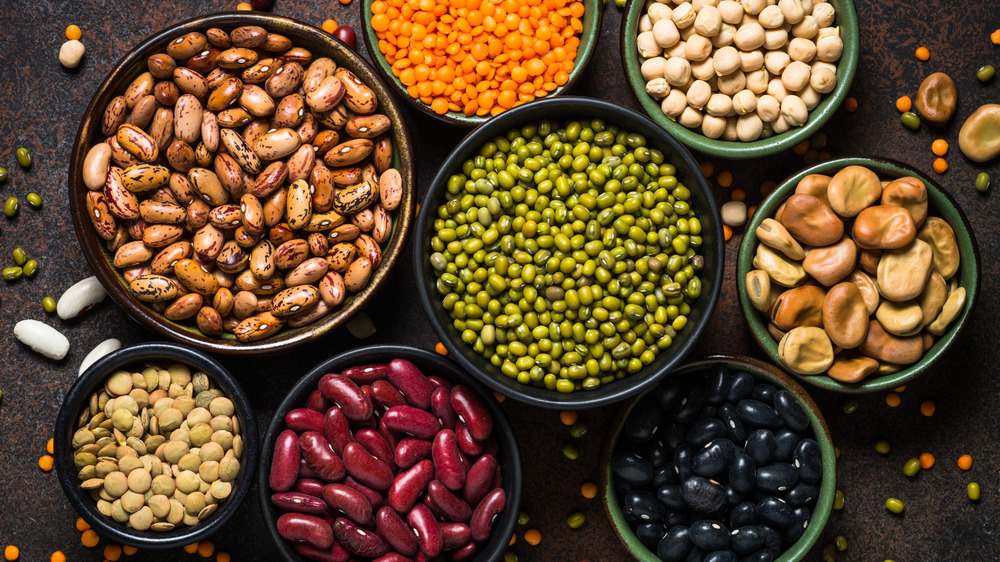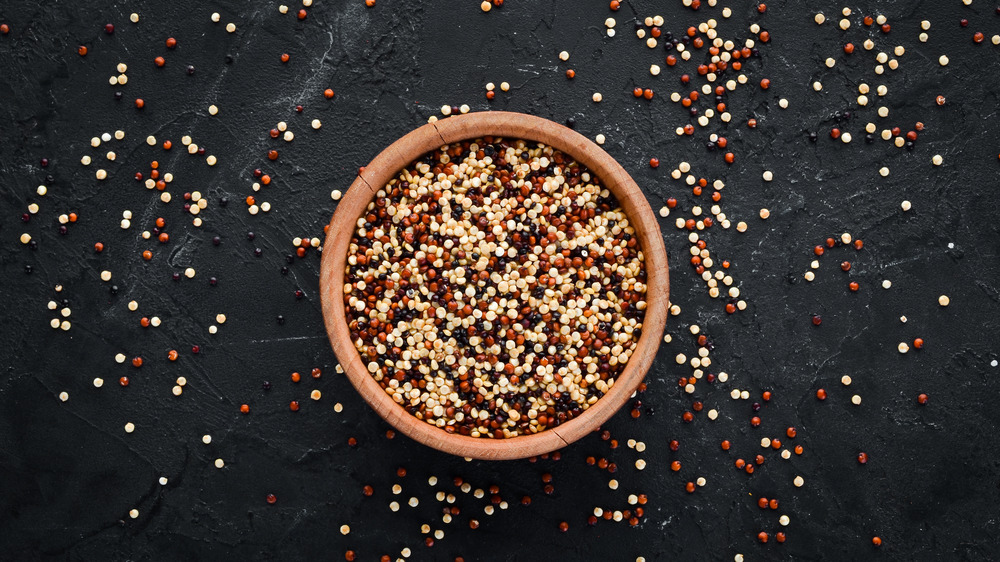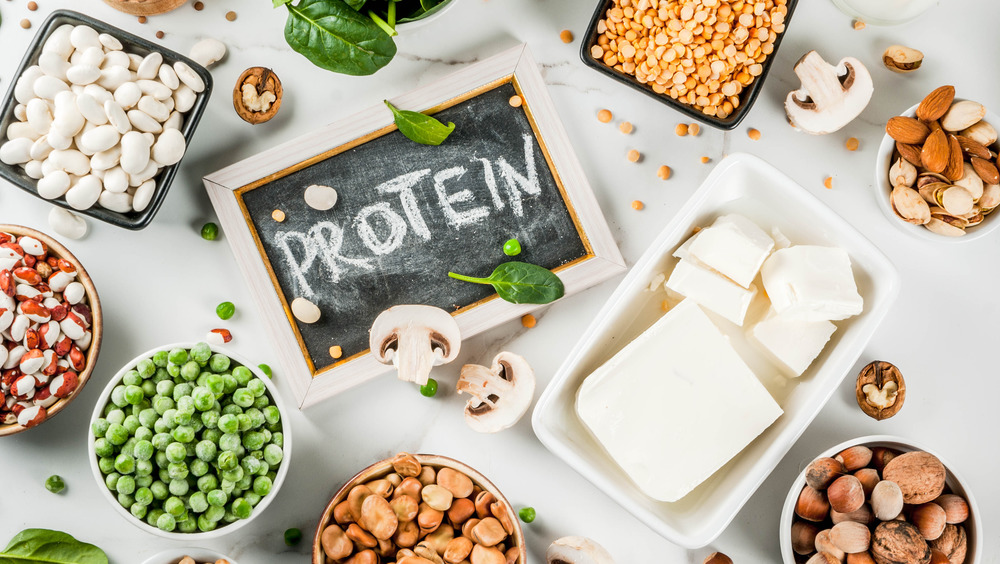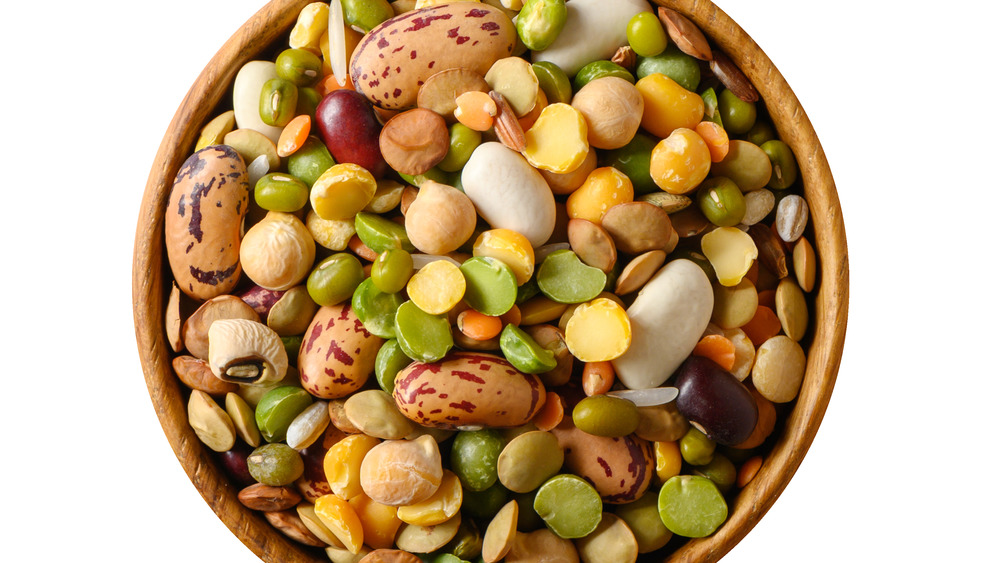Vegetarians Need To Try These Protein-Rich Pantry Staples
Perhaps the most FAQ a vegetarian hears is, "How do you get protein?" (which is usually followed by, "But what about steak?"). Vegetarians, please feel free to bookmark this page and forward it to anyone who ever asks you that question again, because there is a plethora of vegetarian-friendly, protein-rich foods to choose from.
Let's discuss the building blocks of proteins: amino acids. According to Healthline, our bodies do make some amino acids, but it's up to us to supply the rest through our diets. Those that our bodies don't make are called essential amino acids. There are nine of them: histidine, isoleucine, leucine, lysine, methionine, phenylalanine, threonine, tryptophan, and valine. So, contrary to animal-based protein, which contains all nine essential amino acids and is thus considered to be a "complete" protein source, some plant-based proteins contain very low amounts of essential amino acids or are missing some altogether. But not to worry: Vegetarian-friendly complete protein sources do exist, and even if you opt out of the complete sources of protein, you can still toss enough of these protein-rich pantry staples together to make sure you get all nine of those essential amino acids.
When you think of protein-rich grains, your first thought might jump to quinoa. To clarify, quinoa is technically a seed, but it's classified as a whole grain. According to Harvard, it's been cultivated for around 5000 years, so people have been taking advantage of its abundance of plant protein and fiber for a pretty long time.
Seeds, grains, whatever they are, they're full of protein
Just one cup of cooked quinoa provides about eight grams of protein and five grams of fiber. Plus, it's rich in manganese, phosphorus, magnesium, folate, and thiamin (vitamin B1). And remember when we were talking about those vegetarian-friendly complete protein sources? This is one of them. Bonus points for it being naturally gluten-free! (Pro tip: Quinoa is among the foods you should definitely be eating right after a workout.)
As beloved as quinoa is, it's not the only grain (ahem, seed), that's full of protein. In fact, here are six more grains (also technically seeds) that actually contain even more protein than quinoa: spelt, Kamut, teff, amaranth, and sorghum (via Women's Health). Ever heard of them? If not, here's what you should know: Spelt is chewy and has 10.67 grams of protein in one cup. Kamut nutty and buttery and 9.82 grams of protein per cup. Teff is slightly sweet and has 9.75 grams of protein per cup. Amaranth is earthy and has 9.35 grams of protein per cup, and sorghum is a little bitter and has 8.68 grams of protein per cup.
Another FAQ: "So, do you just eat salad, vegetables, and tofu?" Tbh, that combo sounds great, but tofu is definitely not the only protein-rich soy product out there — but since we're already here, let's talk about it.
No, tofu isn't the only soy product out there
Tofu is coagulated soy milk that's pressed into white blocks. It usually comes in three varieties: silken, firm, and extra-firm. Some people are quick to shut down the idea of having tofu because it's too "bland." To that, we'll say: Tofu can pretty much be whatever you want it to be thanks to its ability to easily soak up flavors — and if it's not absolutely delicious, you're probably making some common mistakes when you prepare it. (Can we just break that tofu-is-gross stigma, please?)
As for its protein content: According to Healthline, "A 3-ounce (85-gram) serving of tofu provides approximately 8 grams of protein. It also offers 15 percent of the Daily Value (DV) for calcium, as well as smaller amounts of potassium and iron."
As far as soy products other than tofu, veggie burgers are another protein-rich pantry staple. The only issue here is there are a lot of different kinds of veggie burgers, which makes it hard to generalize how much protein is in one without getting too specific. For example, we have Dr. Praeger's All American Veggie Burger. According to Eat This, Not That!, this is the best burger to invest in if you want to get the most protein — 28 grams per patty, to be exact. If you're not feeling the pull of tofu or veggie burgers, some other protein-rich soy products vegetarians can use are tempeh and edamame.
Don't forget the legumes
Before we dive into this, here's a quick definition of "legumes," courtesy of Healthline: "Legumes is a general term used to describe the seeds of plants from the legume family, which includes beans, peas, lentils, and peanuts." Keep that in mind as we navigate this.
First up: rice and beans. Not only are they a deliciously classic combo, but together, they create a complete protein source. While brown and white rice are low in lysine and high in methionine, beans make up for it by being high in lysine and low in methionine. Talk about a perfect match. According to Healthline, one cup of rice and beans is equal to 12 grams of protein and 10 grams of fiber.
You might be wondering what kind of beans you should really be eating with that rice, which is where a list from Eat This comes in handy, ranking beans from highest to lowest according to their protein levels. An abridged version: Buy some Great Northern Beans. Seriously, you get 9.5 grams of protein from just half a cup of those.
Lentils are your next-best option, touting nine grams of protein per half-cup. Some other great options, in order of most- to least-protein-rich: split peas, black beans, black-eyed peas, navy beans, pinto beans, cranberry beans, and red kidney beans. (By the way, in case you're wondering, eating beans every day will have their own effects on you — many of them quite positive.)



